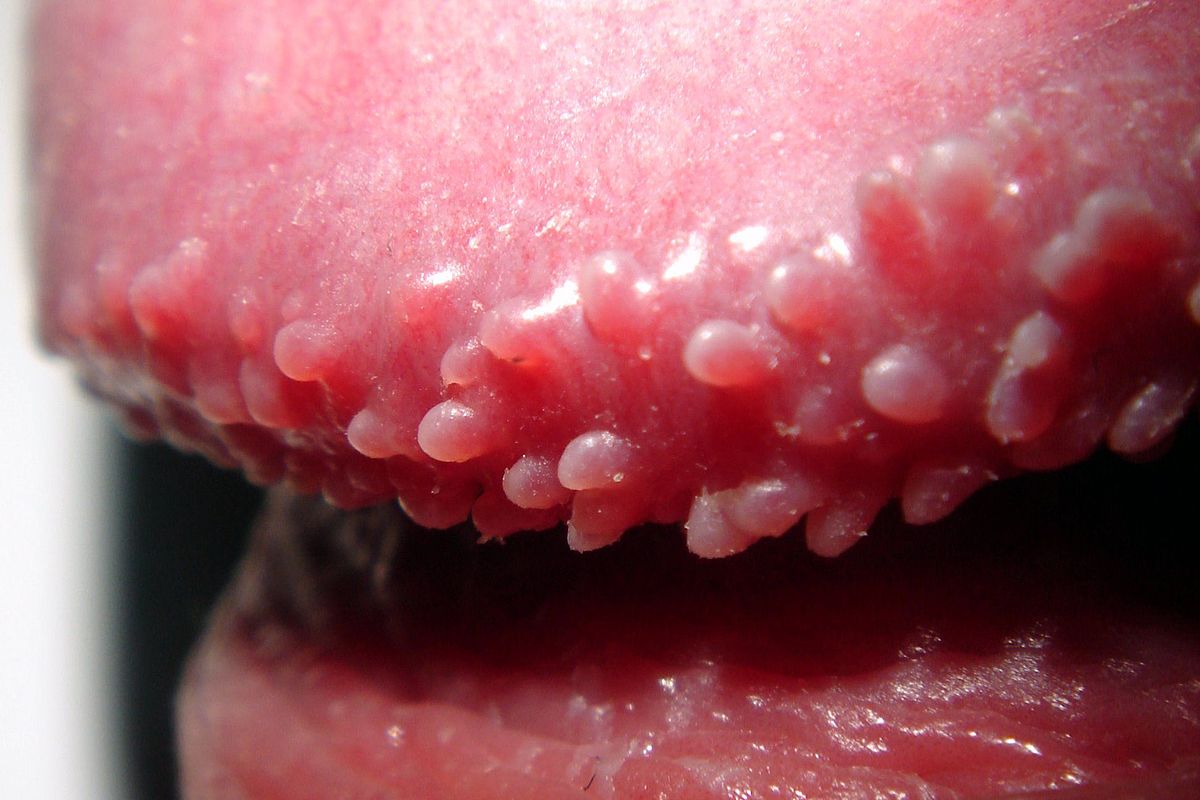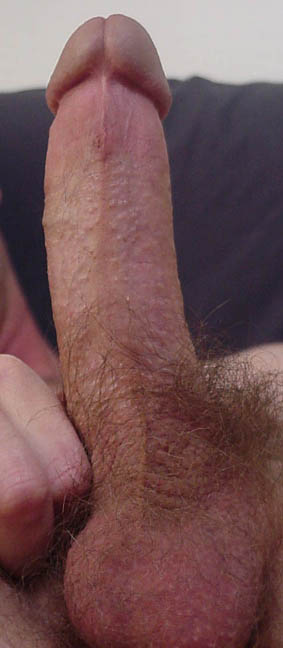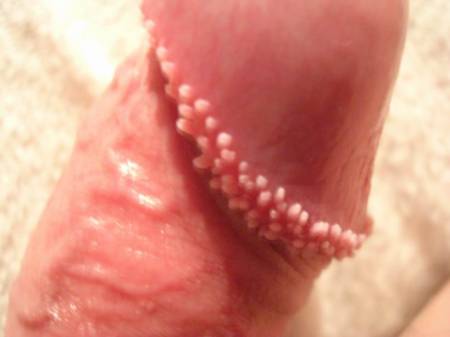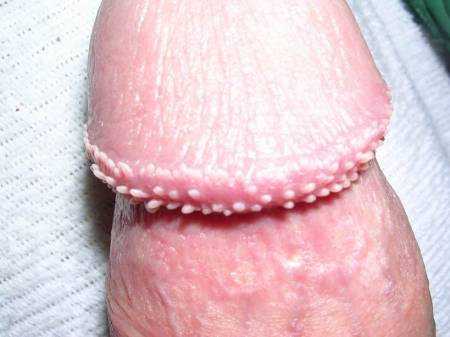|
|
The technical name for Pearly Penile Papules (also known as 3P or PPP for short) is Hirsuties coronae glandis. They are small pearly white bumps which form on the coronal rim of the glans of the human penis. They're not a sexually transmitted infection, they are not contagious, and they are not associated with warts or any other kind of infection. In other words, they are not a sexually transmitted infection. They are a natural human anatomical variation. But although you might be relieved to know that you haven't got any kind of disease, you're probably not too happy that you have these papules. They do not look particularly attractive. So to be told that they are a natural, harmless anatomical variation is probably no comfort. Pearly penile papules on the glansOn this website, you can learn more about them, and hopefully find a solution which will enable you to remove them once and for all. That should save you some embarrassment, and it should save you any shame, embarrassment and difficulty with sexual partners -- and give you a much more attractive looking penis. What Do These Papules Look Like? How Do I Know That's What I Have?You can see some pictures below. PPP can form in one or more rows of little pearly or flesh coloured bumps situated on the coronal rim of the glans. They vary in size from 1 to 3 mm. The "science" page on this site quotes some research which suggests 20% of men have them - that's an astonishing 1 in 5. They appear to be more common in younger men and those who are uncircumcised. The main problem with 3P is that they are aesthetically unpleasant - they just don't look very good.
Common Myths About Pearly Penile PapulesFirst of all the most common myth is that they are a sexually transmitted infection. Well, they are not any kind of infection. We know that with hundred percent certainty. Having said that, we don't know quite why they form - but we do know that it's nothing to do with either sexual activity, or a lack of personal hygiene. Clearly there is some association with circumcision, in the sense that circumcised men appear to have them less often, but as yet, there is a clear answer as to why they form. But Can't You Just Pop Them? Sadly not, as you will know if you've tried! They don't pop, they are not zits or pimples, and if you do try and pop them, you will simply end up with either scarring or a damaged glans. They Are Some Kind Of Hereditary Problem, Yes? NO! Pearly penile papules aren't hereditary, and they aren't a birthmark, and the fact that you have them doesn't mean that your father has them ... it's just a matter of chance. They Make Me Feel Awful -- I Must Be the Only Person in the World Who Has Them Well I know you're not going to be discussing this with your friends, except your very close friends if you have a great deal of trust in them! (Although gay men made have more opportunity to examine them and talk about them than heterosexual men, for obvious reasons). So it's quite likely that you probably don't know how common they are, and you probably don't know that they can appear and disappear, or that they're actually extremely common in men in their 20s and 30s, and that they tend to occur more in uncircumcised men. They don't mean anything about you or your penis, your sexual habits, your sexual history, and they certainly aren't a punishment from God for masturbating as a teenager! So How Do I Get Rid of Them? Well, you can go to a medical specialist, and pay a great deal of money, or you can use a home treatment program like the one on this website. OK, So Why Would I Want To Get Rid Of Pearly Penile Papules? Well, I think you already know the answer to that question - they may not do any harm, and they are certainly not an infection, but they don't look too good, and a lot of men are concerned about the appearance of this condition and what their sexual partner will think about them. In particular, it might be difficult to convince a woman that they are not a sexually transmitted problem. I've Heard of Something Called Fordyce Spots. What Are They? Fordyce spots look like this.
Fordyce spots affect most men. Nearly all men, in fact. They are little white or yellow spots on the skin of the penis, appearing just below the surface of the skin, and usually more or less flat. They generally pose no problem whatsoever, because there aren't that many of them. However, in some cases men have so many Fordyce spots that medical treatment might be a good idea to improve the cosmetic appearance of the penile shaft. Neither of these conditions is contagious, neither offers any threat to your health, and the problems they produce are simply cosmetic and psychological. Fordyce spots are usually located on the shaft of the penis, while PPP (papules) can usually be found on the rim of the glans. The Science Of PPPThere’s a fascinating piece here from David M Kingsley, Ph.D. about the difference between penile spines and pearly penile papules. He was one of the scientists who identified the role of the regulatory element of the androgen receptor gene in forming the keratinized spines which are found on the penis of many animal species, for example mice and chimps. These penile spines only form in response to androgen signalling, and Kingsley and colleagues have discovered that the necessary regulatory genes for the formation of penile spines have been deleted in humans from the androgen receptor gene. Clearly there is an obvious link between the deletion of the highly conserved regulatory element that is normally expressed in the formation of penile spines and the absence of the spines in human beings. However, it’s clearly a logical question to ask whether there is any connection between pearly penile papules and penile spines. (3P are also known as Hirsuties papillaris genitalis or Hirsuties coronae glandis.) As we know, PPP take the form of small projections between 1 and 3 mm in diameter, around the glans of the penis in a significant number of adult human men. However the first indication that there is no connection between penile spines and 3P is the fact that they look very different when subjected histological analysis. As you can see from the illustrations below, penile spines are due to an accumulation of keratinized epidermal cell layers. By contrast, PPP are constituted of our pockets of the entire skin’s surface, with connective tissue making up the majority of the internal structure of the projection. Equally, human PPP do not have neural structures, which contrasts markedly with the penile spines in other animals. So although there is plenty of evidence to suggest that PPP are some kind of morphological variants, they are clearly totally distinct from this penile spines found in other animals, and form by different mechanisms — which are yet to be elucidated. But the concluding and conclusive evidence that there is no connection between the structures is the fact that whether a man has PPP or not does not bear any relationship to the presence or absence of the penile spine regulatory sequence in the androgen receptor gene. In fact, as stated before, all human males who have been checked appear to have no regulatory sequence for the control of keratinized penile spine formation. Possible CuresThe world being the way it is, male vanity being what it is, and female suspicion being what it is, there’s no surprise that the Internet is full of information about curing pearly penile papules (3P). However much of the advice provided is weird, if not downright unsafe. Of course men want to get rid of these things, because they are esthetically unpleasant, and women will always suspect that they are a sexually transmitted disease, unless they have specifically learnt that is not the case. And doctors, who tell patients that they are just a “normal human variant” deserves censure as well, for not exploring the emotional impact, let alone the possible sexual rejection, that 3P can produce. The truth is these things are hideous, and most men who have them want to get rid of them. That’s why there are so many so-called “cures” on the Internet. When you actually research these cures, you find some really interesting and frightening material. For one thing, there’s widespread disgust and dislike of the appearance of these things even among men — hardly surprising, since they can be quite disfiguring and unpleasant. Equally alarming, is some of the information is provided about how people got rid of them. In one forum there’s information about people getting rid of them with a soldering iron, or filing them off with a nail file. I’m not saying that I’m surprised by this, because human nature is endlessly ingenious, and 3Ps are rather unpleasant. But I do encourage men to take some responsibility for their well-being, and to try and understand the dangers implicit in applying a soldering iron to tiny skin protrusions on the edge of your glans – and that’s just one example of the extreme kind of treatment that men have tried. I find it incredible that men would actually take part in a debate about whether or not they could burn their papules off with a soldering iron — anyone who’s used a soldering iron will know that you can’t possibly handle it accurately enough to avoid touching the flesh around the papules, causing intense pain and long-term burn damage. I’ve seen other forums where men have signed up with 20 or 30 identities, so that they could put posts on to testify about their own systems and recommendations. I’m not saying that’s happening here, but boy oh boy, the idea of applying a soldering iron to the early penile papules, on the head of your penis is utterly weird — and very dangerous, too, in my opinion! Even the way some of those emails are written makes them look like the product of a madman, with no punctuation, long-running sentences that don’t make sense, and defensive observations that just look positively outlandish. Actually the whole debate stinks — doesn’t sound the least bit genuine, doesn’t sound like something people have actually tried, and looks really dangerous. So – can we agree you won’t use a soldering iron on your own penis? One of the more encouraging posts, which is written in a credible fashion, using good grammar and punctuation, talks about one of the more popular remedies available on the Internet — tea tree oil. This guy gives a detailed protocol of how he did it, and explains that although it’s a fairly labor-intensive process, of applying the tea tree oil every 2 to 3 hours, it does actually produce a reduction in the size of the PPP, and then finally causes them to drop off. He makes the point, quite correctly in my opinion, that while pearly penile papules do actually often come off in time of their own accord, a fact demonstrated by the predominance of them in younger men, you might want to avoid the embarrassment, lack of sexual confidence and sexual rejection that can ensure when women see these things. And certainly if you can’t afford a visit to a doctor with the carbon dioxide laser, then you are going to want to find some kind of home treatment. Now whether or not home treatments work is always a debatable question, open to challenge, but this guy provides a very powerful and detailed testimony about how easy it was to remove PPP with tea tree oil, and how it’s actually helped. What he says is that although he himself had never experienced any negative feedback from sexual partners, because having PPP is a very normal state of affairs, he does observe that his motivation for their removal was simple so that he could have a smooth penis head. His wife, he says, thinks he’s “mad for trying to get rid of a completely normal thing”. But the point is that it was his preference to get rid of them, and he decided to do it by using a self-help remedy. What he’s found is that it was comparatively easy once you’ve made the decision to actually use a safe remedy. No nonsense about burning them off with a soldering iron, which is both dangerous and stupid. Video – some good advice about pearly penile papules
How Many Men Develop Pearly Penile Papules?A study back in 1966 revealed that, out of 229 men examined in a sexual health clinic in Houston, Texas, one in five had a significant number of pearly penile papules (PPP). Although PPP can vary in their appearance, in an individual man they all look the same. They range from 1 to 2 mm in width and 1 to 4 mm in length. They may be pink, they may be white, sometimes they’re almost translucent, and sometimes they have a yellowish tinge. Most often they are oriented in a single or double row on the coronal rim of the glans, sometimes forming a complete circle around the coronal rim, but generally being most obvious on the back of the corona and less prominent on the front, near the frenulum. Sometimes they spread all over the upper surface of the glans, and very occasionally they have been described on the penile shaft. They are asymptomatic, which means that they do not cause any problems, and they do not cause any feelings of discomfort. So what do they do?Well, because they are seen after puberty, there could be an association with sexual activity or with changes in hormone levels, but neither of these ideas has been proven. Dermatologists have investigated the structure and histology of PPP and have found that they resemble the structure of fibromas of various parts of the body. (A fibroma is a benign growth of connective tissue.) The short answer is that their function is probably not known because they have no function. This raises the possibility that they are what are known as phylogenetic residues from our animal ancestry. In other words, there may have been some structure on the penis of other mammals which served some function during sexual activity, and even though those particular tissues have become redundant in human males, the phylogenetic residue may manifest as a pearly penile papule. More detailed analysis of the structure of PPP have demonstrated that they contain fibres of collagen, fibroblasts, capillaries and venules, and other normal cells of the dermal layers. However, this tells us nothing about their origin and their function (if they have one). As always, reviews of PPPs in the literature tend to conclude that they are benign and do not require any treatment except “reassurance” of the patient. This is an arrogant and unsatisfactory position to take: they are not esthetic, indeed, in some men they can be quite aversive to sexual partners. I believe men who are upset about them have every reason to expect the medical profession to remove the papules if possible. Unfortunately, in many countries this is regarded as an optional or elective cosmetic procedure, and is only available through private treatment. https://onlinelibrary.wiley.com/doi/10.1111/ijd.2004.43.issue-3/issuetoc Medical Treatment Is PossibleThe medical profession can treat pearly penile papules, but they may not elect do so: a conservative attitude would suggest that treatment should be reserved only for men who are extremely distressed by the appearance of what has been described as “this very common and benign entity”. However, the truth of the matter is that they are unattractive, and their presence can stigmatize a man whose penis is regarded as “abnormal” by his sexual partners. Options for treatment by the medical profession include cryotherapy, electro-desiccation, and carbon dioxide laser ablation.
Different surgical methodsCarbon dioxide laser surgery uses highly specific carbon dioxide lasers to produce intense beams of infrared light, which disrupts the papule tissue at the molecular level. This is generally regarded as the most effective medical approach to the problem. Cryosurgery involves freezing the papules to very low temperatures using liquid nitrogen after which they will automatically detach from the corona. Conventional excisional surgery simply removes the papules one by one using a scalpel or lancet. Electrodesiccation uses electricity to drive the papules, or desiccate them, after which they can be removed by scraping with surgical instruments. This is the least acceptable and successful form of surgery. And they do disappear naturally….The fact that men who are circumcised show fewer PPP than uncircumcised men may suggest that the normal friction of the coronal area against clothing might be one way of causing their regression. Therefore if uncircumcised men chose to keep their foreskin rolled back, it might be possible to accelerate the regression or disappearance of PPP. They are also less common in older men; they regress with age. Origin of PPPIt’s been suggested that the penile spines and vibrissae which are seen in other mammals may appear in a vestigial form as pearly penile papules in humans. However research on the genetics of this particular aspect of animal physiology has demonstrated that the relevant genes that cause penile spines to form in other primates and mammals are completely missing in all the human men who have been studied. This theory therefore seems somewhat unlikely. https://www.plosone.org/article/info%3Adoi%2F10.1371%2Fjournal.pone.0084258
|







